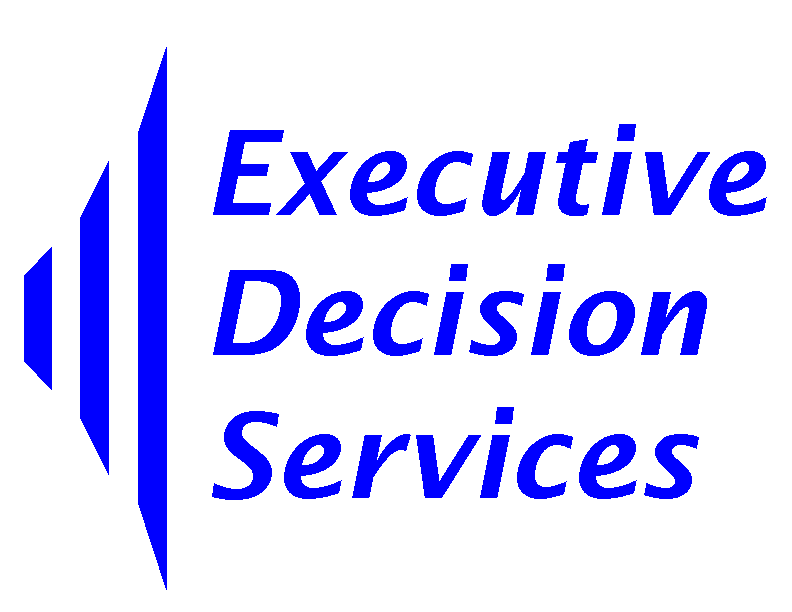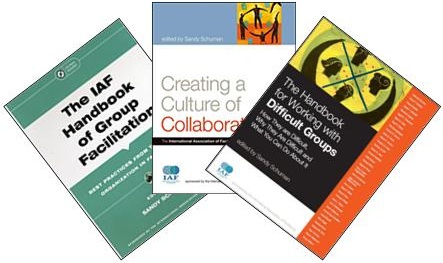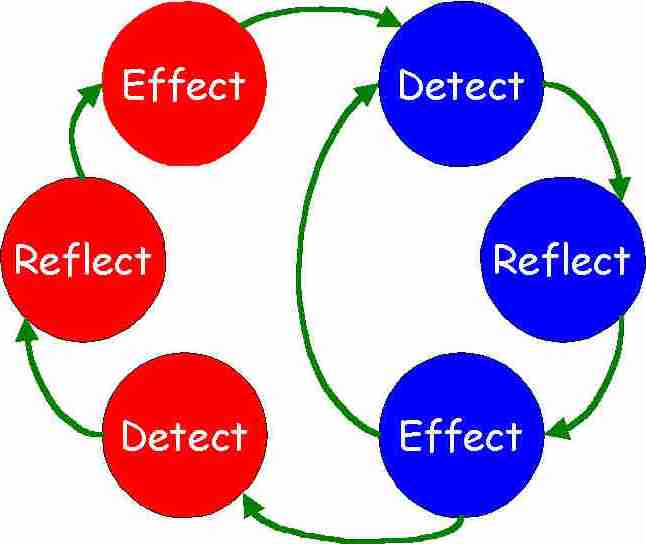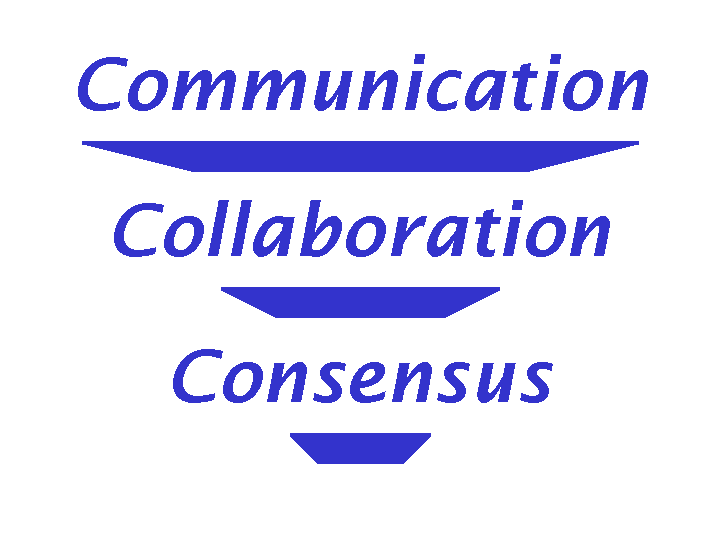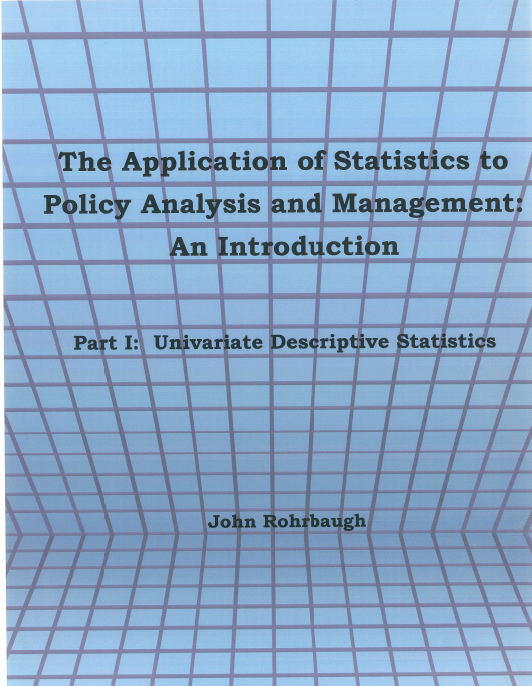Creating a Culture of Collaboration:
What Everyone Should Know
Group Facilitation:
Essential Skills for Managers, Team Leaders and Change Agents
Improving Group Effectiveness:
Building Your Capacity to Work with Groups
Upstream Facilitation: How to Plan Effective Meetings
What Would You Do ‑ and Why?
Critical Incidents in Working with Groups
Analytical Methods for Group Problem Solving & Decision Making
Stories at Work: How to Create, Tell, & Use Stories to Communicate Effectively
Conflict Management and Conflict Management Systems:
Managing Conflict Throughout Your Organization
Communicating Bad News and Tough Decisions
Systems Thinking:
Making Sense of Complex Situations
Using Computer Technology to Improve Group Productivity:
Before, During, and After Meetings
Collaboration is hot! There has been a lot of talk about collaboration, group facilitation, and generally, improving the way we work together among ourselves and with others. Is this an important direction for your organization? If so, what are some specific steps we should take to move that way? This session will seek to answer these and other questions, such as:
· Why is "collaboration" receiving increasing attention in groups, organizations, communities, and society?
· How is "working collaboratively" different from other ways of working?
· Would your organization benefit from working more collaboratively?
· What are the values, principles, and beliefs underlying collaboration?
· What would you need to do to make collaboration work?
This workshop draws extensively on the material presented in Creating a Culture of Collaboration, Sandy Schuman, Editor, Jossey-Bass Publishers, 2006.
Examples:
· Conflict, Negotiation, and Collaboration
· Critical Incidents: What Would You Do, and Why?
· The Role of Facilitation in Collaborative Groups
Group
Facilitation:
Essential Skills for Managers, Team Leaders and Change Agents
To address today's complex issues individuals and organizations with diverse perspectives must come together to create a shared understanding and develop consensus solutions. How can you help your group members work together more effectively? Group facilitation is a core competency for managers, team leaders and change agents. In this workshop, you will practice basic group facilitation skills that will enable you to work with a group to elicit, clarify, analyze, and evaluate ideas. These skills are useful in working with any group: ongoing, single-organization teams (e.g. work groups, executive teams) as well as ad-hoc groups that include representation from multiple parties (e.g., expert panels, task forces). You'll gain an understanding of the role of a group facilitator, how to prepare for meetings, and how to select and arrange the meeting space.
In this workshop you will learn:
Definitions of basic group facilitation terms
What is facilitative leadership? What are the goals and roles of the facilitator?
What it means for a facilitator to be neutral, impartial, or disengaged
Why "brainstorming" is a weak method for generating ideas, and what's better
Understanding the role of the sponsor, convener, participant, stakeholder, and content expert.
In this workshop you will practice:
How to interact with a group in the role of group facilitator
How to elicit ideas and information from groups
How to conduct
the six-step Nominal Group Technique (NGT)
(silent generation of ideas, round-robin recording, serial clarification,
preliminary vote, discussion, final vote)
How to clarify the group's problem or purpose
Content outline:
· Understand the Role of the Facilitator
The differences in the roles of facilitator, participant, and other roles in the decision making process
The role of meetings in the context of decision making
How the facilitator can support the social, cognitive, and political processes that occur in group decision making
· Build a Conceptual Basis for Acting as a Facilitator
What a facilitator does: Detect, Reflect, Effect
Goals of facilitation: Participation, Adaptability, Efficiency, Accountability
· Develop Facilitation Skills
Practice facilitation skills using Nominal Group Technique
Receive feedback from other course participants and instructor
Develop observation and feedback skills
Individual skill development exercises for using a flip-chart
Examples:
View an example website set up for participants of a Group Facilitation two-day workshop or an afternoon conference session.
Improving Group Effectiveness:
Building Your Capacity to Work with Groups
While groups focus on their assigned tasks, they should also invest in improving their ability to work together effectively. In this workshop, you'll examine your assumptions about group effectiveness, when and how to intervene in group processes, how to establish and use ground rules, and how to help a group learn about itself. Individuals will benefit most from this workshop if they have prior group facilitation experience.
In this workshop you will learn:
· How to assess your abilities regarding effective group decision making
· How a group develops and changes over time
· How individual behavior impacts group process
· How to decide when and how to intervene in the group process
· How to use ground rules to improve group performance
· What distinguishes teams from other types of groups
· How and when to develop a team
Content outline:
· Collaborative Decision Process
A self assessment of your group-facilitation capabilities
A tool to help groups assess their collective strengths and weaknesses
· Ground Rules
When to use them; which ones to use; who should enforce them; what to do when they are violated
· The Intervention Cycle
Detect, Reflect, Effect
· Group Development
Tuckman’s forming, storming, norming, performing, adjourning
More recent perspectives on group development
Intervening to strengthen group development
· Groups vs. Teams
Are the differences real? Important?
Establishing appropriate expectations and internal commitments
Using the Index of Interdisciplinary Collaboration
Upstream Facilitation:
How to Plan Effective Meetings
Most of the reasons why meetings are difficult or fail can be traced to things that occurred (or did not occur) prior to the meeting. This workshop focuses on how to prepare for meetings to make the most productive use of the time at the meeting. Topics include how to: work with the meeting sponsor and/or convener to clarify the purpose of the meeting; identify and invite the appropriate participants; envision appropriate outcomes or products; select and arrange the meeting place; present background information and bring participants "up to speed;" provide continuity between meetings and establish a "decision-making process" view rather than a "single meeting" view; select appropriate technology for collecting and displaying information; and select appropriate procedures to meet the group's needs.
In this workshop you will learn:
· How to work with customers, sponsors and conveners
· How to select and arrange a room to the group's advantage
· How to assess your information technology needs and expand your options
· Pitfalls in contracting with the group
· The Seven Ps of Preparation
People
Purpose
Product
Place
Process
Presentation
Post
· The critical relationships between people, purpose, and product
What Would
You Do ‑ and Why?
Critical Incidents in Working with Groups
What can you do to prepare for the unanticipated? How can you act in the face of the unexpected? How can you "think on your feet?" This workshop is for experienced facilitators, team leaders, and project managers who are willing to share "critical incidents." Critical incidents can help us examine how and why we might react differently to a given situation. We'd like to bring into focus the principles and values that guide our practice by examining critical incidents. Workshop participants are asked to identify critical incidents as follows:
Can you think of a situation that challenged you as a group facilitator, team leader, or project manager? … that resulted in your learning something fundamental about your practice? … that caused you to feel proud that you did the right thing, … or made you wonder if you had?
By examining these incidents as a group, we can gain insights from each other regarding the principles and values that underlie our practice as well as specific techniques we can use to address particular situations.
In this workshop participants will:
· Critically examine the Statement of Values and Code of Ethics for Group Facilitators and Facilitator Core Competencies adopted by the International Association of Facilitators.
· Use the critical incident technique to explore the integration of theory and practice.
· Examine their own values and the consistency of their behaviors with those values.
· Explain their behaviors with respect to professional values and ethics and knowledge of group processes.
Content:
The structure I use for critical incidents is simple but powerful. I describe a real group facilitation situation in which I have been involved. When I get to a point where there was a challenge (a procedural or ethical issue, problematic behavior, or something else that gave me pause) I interrupt my description and ask, "what would you do, and why."
Typically a number of people respond, describing the action they would take and the reasons for same. This provides a concrete basis for exploring different perspectives and reconciling "espoused theory" and "theory in use." Sometimes there are spin-off discussions on related topics. Some of my critical incidents involve a number of such "interruptions" as the situation unfolds. Presentation and discussion of a critical incident might take anywhere from one-half to two hours, depending on the complexity of the case. While I will be prepared to present a number of critical incidents, participants are asked to bring their own for the group to explore.
Analytical Methods for Group Problem Solving & Decision Making
To address complicated issues it is often necessary to integrate objective facts and data provided by subject matter experts as well as subjective judgments and values provided by stakeholders. Decision modeling provides the analytical framework to enable this integration, while group facilitation provides the social framework. In this course, you will learn how to work with group participants to develop a model, study its implications, make alternative assumptions, and incorporate new ideas to build consensus decisions.
Decision conferencing was developed in the late 1970s with funding from the Defense Advanced Research Projects Agency and the Central Intelligence Agency. It is based on the integration of decision analytic theory, social and cognitive psychology and information management principles. It was adopted in the early 80’s by the University at Albany’s Decision Techtronics Group, where Sandor Schuman served as Executive Director.
In this workshop you will learn:
· How group facilitation and decision modeling can be integrated to support decision making in complex and uncertain situations
· When to use different types of analytical tools such as: Venn diagrams, flow charts, word & arrow diagrams, multiattribute utility analysis, resource allocation, judgment analysis
· How to build multiattribute utility and resource allocation models
· How to use decision models to:
Decompose a problem into its component parts, conduct detailed analyses, and aggregate the results
Manage complicated situations involving complex sets of facts, trade-offs, and ambiguous relationships
Systematically integrate a group’s subjective value judgments with objective information
Use cognitive feedback to help groups refine their model
Content outline:
· Overview of decision conferencing
What is decision conferencing? How does it work? What does it look like?
What makes it effective or ineffective?
· Overview of decision models
Four types of models and when they should be used
Group process problems that models can address
How models can be integrated with facilitation
· Building a multiattribute utility model
Where have multiattribute utility models been used?
7 Steps for building a multiattribute utility model
Case study: Siting the Ultra City Office
· Building a resource allocation model
Where have resource allocation models been used?
9 Steps for building a resource allocation model
Case study: The Northington Library
Stories at Work: How to Create, Tell, & Use Stories to Communicate Effectively
The stories you tell can say more than your slides, handouts, and reports. This workshop helps you “tell your story” to share knowledge, promote values, and foster change in your role as leader, manager, trainer, or consultant. You will be able to explore storytelling and how it might be integrated into your practice. Building on their own experiences you will enhance your ability to create and tell stories and help others create and tell their own stories.
In this workshop you will learn:
· the components of effective story content
· the dimensions of effective story telling
· how to tell a story, including practice exercises
· tools for drawing on their own experiences to create stories and helping others create their own stories
· the uses of storytelling in facilitation, training and consulting
Content outline:
· Why tell a story
Comparison of storytelling to other forms of communication
· Story dynamics
Teller, story, audience
Listening, learning, and telling
· Example: The Credit Union that Could - a story for training group facilitators
What does this story mean to you? (individual, small group, and large group reflection)
What does this tell us about listening, learning, and telling stories?
· Learning to tell the story
Two new stories: The Uncomfortable Participant; The Meaning of Wilderness
Learning the story: work in pairs; retell the "bones;" one character's perspective; image-ine the story; share results
· Creating your own stories for facilitating, training, consulting
Exploring your experience through word association
Components of story content
Components of story telling
· Eliciting stories from groups
How to use these exercises with groups
· Strengthening your storytelling skills: Exercises and practice
Telling skills: voice, posture, movement, gesture, emotion, expression
Content skills: purpose, characters, imagery, event, tension, resolution
Conflict
Management and Conflict Management Systems:
Managing Conflict Throughout Your Organization
How we deal with conflict can have lasting effects on our personal lives, our careers, and on the organizations in which we work. Addressing conflict effectively can be very rewarding; responding to conflict poorly can be devastating.
In this workshop you will learn:
· Different ways in which people approach conflict and the strengths and weaknesses of those approaches.
· How communication affects interpersonal conflict, in particular the role of inference making.
· A perspective that looks at conflict at the interpersonal, organizational and inter-organizational levels.
· Impacts of conflict at the personal and organizational levels.
· How people approach conflict individually, and how organizational conflict management systems address conflict systematically.
· How mediation works and the strengths and weaknesses of two different approaches to mediation and their effects on organizations.
· Design principles for developing effective organizational conflict management systems.
· How conflict management can be applied to interorganizational and multiparty conflicts.
Content outline:
· Overview of Conflict, Conflict Management, and Conflict Management Systems
· Individual Assessment – Thomas-Kilman Conflict Mode Instrument
· Organizational Conflict Management Systems
Is it a good idea to improve your personal conflict management skills? Is it sufficient?
How does conflict manifest itself in the workplace? What can you do about it?
· Conflict Management – a directive mediation approach
Video - Mediation: A Demonstration for Review and Analysis
Conflict steps
· Conflict Management – a transformative mediation approach
Video - Introduction to REDRESS
Transformative interventions
· Design Principles for Conflict Management Systems
Case Study - FHWA Conflict Resolution Program
· Public Policy Conflict Management
Video - Policy Consensus Initiative
Case Study – Bridging Conflict
Communicating Bad News and Tough Decisions
Effective communication is perhaps the most often cited need in organizations. This is particularly important in situations that are uncertain or where circumstances require tough decisions that may be received as “bad news.” Learning how to communicate in these difficult situations helps us to communicate effectively in situations that are more ordinary as well.
In this workshop you will learn:
· Three perspectives on communication and their strengths and weaknesses
· Ten propositions about communication and their Implications for effective communication
· How to plan communications
· How to communicate bad news and tough decisions-
Content outline:
· Arrow, Circuit, and Dance: Three Metaphors for Effective Communication
Video case studies and analysis
· Ten Propositions about Communication and their Implications
Focusing questions
Video case studies and analysis
· Communicating Change: Four levels of Planning
Focusing questions
Video case studies and analysis
· Communicating Difficult Information
Video case studies and analysis
Systems
Thinking:
Making Sense of Complex Situations
Our efforts to improve a complex system are often hampered by our incomplete or disparate views of how the system works or should work. Systems thinking explicitly takes into account the perspectives of various stakeholders and the interconnections of various entities and activities that strive to achieve some purpose. Multiple models may be constructed, each from a different point of view. Comparison of models leads to new insights and the opportunity to reframe the situation. The approach lends itself to working with stakeholders independently, and bringing them together later. Alternatively, all stakeholders can be brought together at once to develop multiple models simultaneously.
Content Outline
· Introduction to systems thinking
Making inferences: balancing believing and doubting
Creating mental models – sharing understandings explicitly
Why is organizational activity like a water faucet?
Why do meetings start late?
· Applying systems thinking to your situations
Description and selection of a few issues/ situations we can work on
· Write system purpose statements
A system to do X (what) by Y (how) in order to achieve Z (why)
Identify three different stakeholders and create purpose statements from each perspective
· Graph change over time
Identify key measures that each stakeholder would use to monitor system effectiveness
The X axis represents time (days, weeks, months, years)
The Y axis represents the measure of effectiveness.
· Draw word and arrow diagrams
Depict key aspects of the system and their inter-relationships.
· Obtain insights
Review purpose statements, graphs, and diagrams
Explore differences in understandings of the system
Obtain insights into how to make system improvements
Using Computer Technology to Improve Group
Productivity:
Before, During, and After Meetings
The use of computer technology for personal productivity is taken for granted. Increasingly it is being used in meetings. However, its predominant use in group settings is to present information (such as presenting PowerPoint slides) rather than to help the group create and manage information, resolve conflicts, and make decisions. This workshop will illustrate several applications of computer technology for use with groups before, during, and after meetings, using readily available hardware and software.*
Content outline:
· Before meetings:
Scheduling meetings and gathering information using web-based survey tools
Establishing the purpose of a meeting or project purpose using email discussion lists
Making documents and other materials available using wikis and web pages
Addressing technology issues when participants are from different organizations or have different skill levels
· During meetings:
Using an electronic flipchart: using the Microsoft Word Outliner®, Inspiration®, FreeMind®, and other products for real-time text and graphic meeting notes
Organizing and reorganizing: the power of hierarchical outliners to manage information
Group wordsmithing: duking out differences in front of everybody to build internal commitment and explicit agreement using Microsoft Word’s Track Changes®
Keeping track of assignments: who should do what by when
Evaluating options to support decision making using Microsoft Excel®
Drawing system diagrams using Microsoft Draw®
· After meetings:
Evaluating meeting effectiveness using web-based survey tools
Ensuring timely completion of follow-up assignments
Maintaining group identity and moving the purpose forward
* While many specialized software products are available and are arguably superior, this workshop emphasizes software that participants are likely to already have or can obtain inexpensively.
